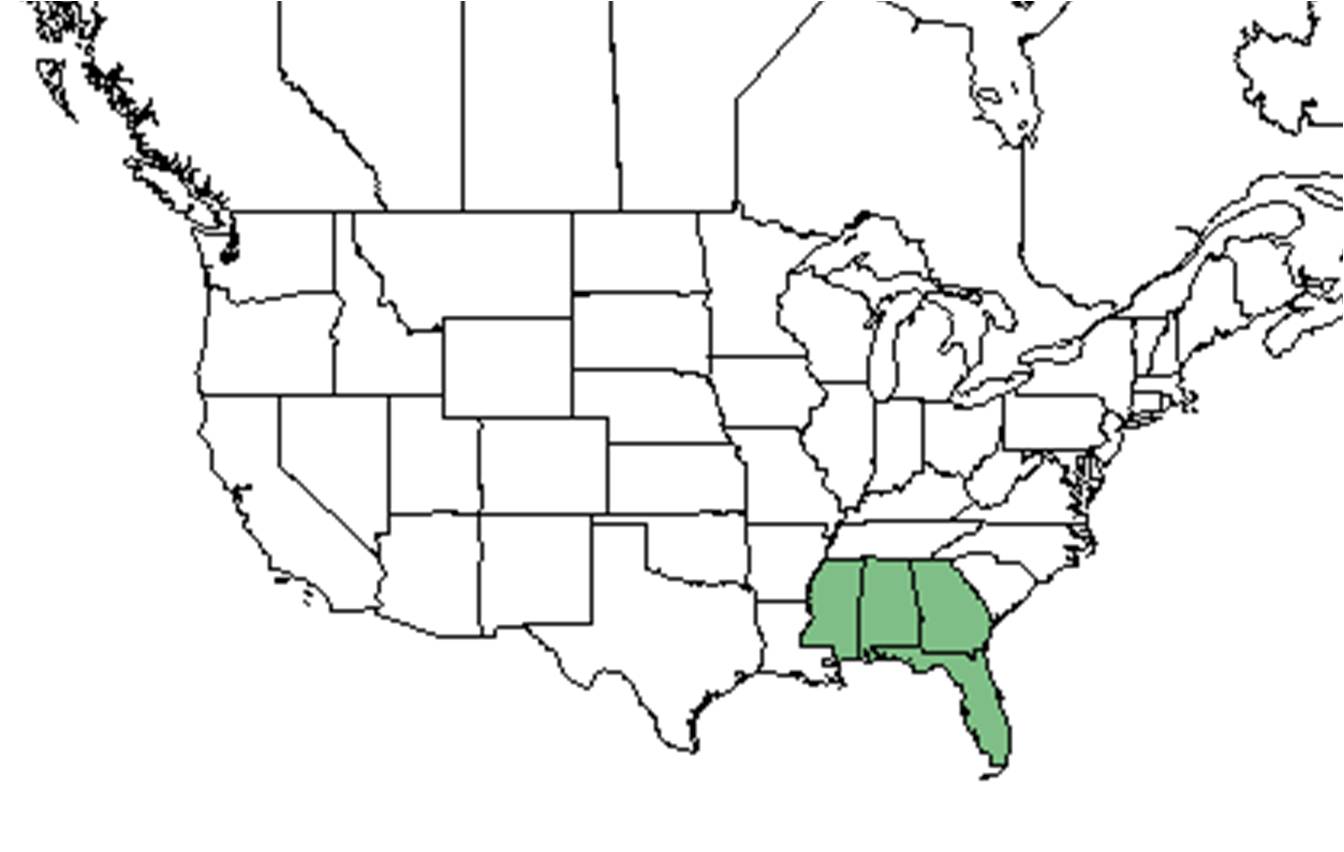Difference between revisions of "Balduina angustifolia"
KatieMccoy (talk | contribs) (→References and notes) |
KatieMccoy (talk | contribs) |
||
| Line 26: | Line 26: | ||
==Ecology== | ==Ecology== | ||
===Habitat=== <!--Natural communities, human disturbed habitats, topography, hydrology, soils, light, fire regime requirements for removal of competition, etc.--> | ===Habitat=== <!--Natural communities, human disturbed habitats, topography, hydrology, soils, light, fire regime requirements for removal of competition, etc.--> | ||
| − | In the Coastal Plain in Florida, ''B. angustifolia'' has been found in sand dunes; turkey oak sand ridges; pine scrubs; rosemary-oak scrub sandridge; scrub oak-longleaf pine ridges; wiregrass/longleaf pine sandhills; pine flatwoods; bordering sidestreams; open woodlands; and xeric oak/saw palmetto scrubs (FSU Herbarium). | + | In the Coastal Plain in Florida, ''B. angustifolia'' has been found in sand dunes; turkey oak sand ridges; pine scrubs; rosemary-oak scrub sandridge; scrub oak-longleaf pine ridges; wiregrass/longleaf pine sandhills; pine flatwoods; bordering sidestreams; open woodlands; and xeric oak/saw palmetto scrubs (FSU Herbarium).There are greater populations of ''B. angustifolia'' in bare, open sands than in sites with shrubs or litter, making it a gap specialist (Stephens et al. 2013). It is early successional species and has been found to have a greater population growth in degraded scrubs compared to intact scrubs (Stephens et al. 2013). It has been found in disturbed areas such as roadsides, highways, powerline corridors, bulldozed scrub oak ridges and clobbered slash pine forest (FSU Herbarium). Soil types include deep sand and loamy sand (FSU Herbarium). Associated species include ''Gaillardia, Pityopsis, Polygonella, Chrysoma, Ceratiola ericoides, Liatris, Leptoloma cognatum, Pinus clausa'', and ''Quercus virginiana'' (FSU Herbarium). |
===Phenology=== <!--Timing off flowering, fruiting, seed dispersal, and environmental triggers. Cite PanFlora website if appropriate: http://www.gilnelson.com/PanFlora/ --> | ===Phenology=== <!--Timing off flowering, fruiting, seed dispersal, and environmental triggers. Cite PanFlora website if appropriate: http://www.gilnelson.com/PanFlora/ --> | ||
Revision as of 14:56, 1 December 2015
| Balduina angustifolia | |
|---|---|

| |
| Scientific classification | |
| Kingdom: | Plantae |
| Division: | Magnoliophyta - Flowering plants |
| Class: | Magnoliopsida - Dicotyledons |
| Order: | Asterales |
| Family: | Asteraceae ⁄ Compositae |
| Genus: | Balduina |
| Species: | B. angustifolia |
| Binomial name | |
| Balduina angustifolia (Pursh) B.L. Rob. | |

| |
| Natural range of Balduina angustifolia from USDA NRCS Plants Database. | |
Common name: Coastal plain honeycombhead
Contents
Taxonomic notes
Description
A description of Balduina angustifolia is provided in The Flora of North America.
Distribution
Ecology
Habitat
In the Coastal Plain in Florida, B. angustifolia has been found in sand dunes; turkey oak sand ridges; pine scrubs; rosemary-oak scrub sandridge; scrub oak-longleaf pine ridges; wiregrass/longleaf pine sandhills; pine flatwoods; bordering sidestreams; open woodlands; and xeric oak/saw palmetto scrubs (FSU Herbarium).There are greater populations of B. angustifolia in bare, open sands than in sites with shrubs or litter, making it a gap specialist (Stephens et al. 2013). It is early successional species and has been found to have a greater population growth in degraded scrubs compared to intact scrubs (Stephens et al. 2013). It has been found in disturbed areas such as roadsides, highways, powerline corridors, bulldozed scrub oak ridges and clobbered slash pine forest (FSU Herbarium). Soil types include deep sand and loamy sand (FSU Herbarium). Associated species include Gaillardia, Pityopsis, Polygonella, Chrysoma, Ceratiola ericoides, Liatris, Leptoloma cognatum, Pinus clausa, and Quercus virginiana (FSU Herbarium).
Phenology
It has been observed flowering August through November and fruiting September and October (FSU Herbarium).
Seed dispersal
Seed bank and germination
Fire ecology
Pollination
The following Hymenoptera families and species were observed visiting flowers of Balduina angustifoliaat Archbold Biological Station (Deyrup 2015):
Andrenidae: Andrena fulvipennis
Apidae: Apis mellifera, Bombus impatiens, B. pennsylvanicus, Nomada fervida, Svastra aegis, Triepiolus concavus
Halictidae: Agapostemon splendens, Augochlora pura, Augochlorella aurata, Augochloropsis metallica, A. sumptuosa, Dieunomia heteropoda, Halictus poeyi, Lasioglossum coreopsis, L. miniatulus, L. nymphalis. L. pectoralis, L. puteulanum
Megachilidae: Anthidiellum perplexum, Coelioxys dolichos, C. germana, C. mexicana, C. modesta, C. sayi, C. texana, Dolichostelis louisae, Megachile albitarsis, M. brevis pseudobrevis, M. georgica, M. inimica, M. mendica, M. petulans, M. policaris, M. pruina, M. texana, M. xylocopoides, Trachusa fontemvitae
Sphecidae: Bembix sayi, Bicyrtes capnoptera, Ectemnius rufipes ais' Philanthus ventilabris
Vespidae: Mischocyttarus cubensis, Pachodynerus erynnis, Zethus slossonae
Use by animals
Diseases and parasites
Conservation and Management
Cultivation and restoration
Photo Gallery
References and notes
Deyrup, M.A. 2015. Database of observations of Hymenoptera visitations to flowering plants on Archbold Biological Station, Florida, USA.
Florida State University Robert K. Godfrey Herbarium database. URL: http://herbarium.bio.fsu.edu. Last accessed: October 2015. Collectors: William P. Adams, Jame Amoroso, Loran C. Anderson, Robert Blaisdell, K.E. Blum, A.F. Clewell, George R. Cooley, Richard J. Eaton, R.K. Godfrey, H.E. Grelen, Bruce Hansen, JoAnn Hansen, Richard D. Houk, R. Kral, Bob Lazor, S.W. Leonard, Sidney McDaniel, Thomas E. Miller, J.B. Morrill, Putnam, James D. Ray Jr., Siri von Reis, Paul L. Redfearn Jr., Paul O. Schallert, Victoria I. Sullivan, Bian Tan, E.L. Tyson, Jean Wooten. States and Counties: Florida: Bay, Broward, Calhoun, Collier, Columbia, Clay, Columbia, Dixie, Escambia, Franklin, Hernando, Highlands, Jackson, Lafayette, Lee, Levy, Liberty, Madison, Manatee, Martin, Okaloosa, Osceola, Pinellas, Polk, Putnam, Santa Rosa, Sarasota, Seminole, Suwannee, Taylor, Walton, Wakulla. Compiled by Tall Timbers Research Station and Land Conservancy.